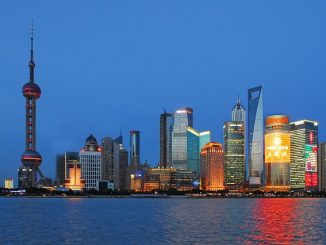Tyler Cowen linked to this excellent FT article on the Chinese economy by Yukon Huang:
In sum, urbanisation largely explains both the decline in labor’s share of income and the increase in savings rates, which together explain the decline in consumption as a share of GDP. Also worth noting is that contrary to popular perceptions per capita consumption has been growing by 8 percent annually — the highest of any major economy — even as the consumption share to GDP has been falling.
China’s unbalanced growth pattern mirrors other successful emerging East Asian economies that went through a similar urbanisation–industrialisation process several decades ago. The consumption share of GDP for Japan, South Korea and Taiwan fell by 20-30 percentage points, bottoming out at adjusted per capita income levels in the range of US$12-15,000 compared with China’s current $9,000. The decline in the consumption share is mirrored by a sustained increase in the investment share of GDP in all three economies, peaking around 40 percent of GDP. The common thread linking all these East Asian countries is that widening imbalances were associated with urbanisation and high growth rates that allowed them to escape the middle income trap and eventually transition to more balanced outcomes as their economies matured.
Misinterpreting the reasons why China’s growth is unbalanced in terms of macro-aggregates leads to the wrong policy prescriptions, including the argument that China needs a more “consumption-led” growth model — a concept which does not exist in economic theory — or that China needs to grow more slowly so that the share of consumption to GDP will increase — which confuses means and end.
But China does face major economic problems brought on by declining productivity and surging debt levels. The challenge for the new leadership is to escape the middle income trap by implementing a complex set of structural reforms so that the economy can grow at around 7 percent for the remainder of this decade. This will not be easy. China needs to improve the efficiency of its urbanisation process and develop more appropriate financing sources. If it succeeds, then rebalancing will eventually occur as a byproduct of a more sustainable growth path but not as the intrinsic objective.
A few comments:
1. Why has consumption grown faster in China than any other major country? Probably due to high rates of investment. Something to keep in mind when people argue that high rates of investment hurt the Chinese consumer. Indeed the fact that China got a later start than Korea and Taiwan means their investment/GDP ratio should peak at an even higher level than the previous tiger economies.
2. Here’s what does hurt Chinese consumers; inefficient SOEs. Huang is right that if China wants to grow at 7% for the rest of the decade it must continue to reform it’s economy. The November meeting will be decisive. I believe they will do further reforms and that China will continue to boom. However I don’t believe growth will still be at 7% by 2020. It will slow modestly, perhaps to 6%.
PS. How inefficient are Chinese SOEs? Very:
The big banks have been here before. In the 1990s an elaborate bail-out was devised to recapitalise the Big Four and transfer dud loans to asset-management companies. It is improbable that a big Chinese bank would be allowed to go under if a similar situation arose again. Nevertheless their market share is rightly under threat.
Three changes in particular are weakening their position. The first is the stagnation of SOEs, which stands in sharp contrast with the dynamism of the “bamboo capitalists” in the private sector. Nicholas Lardy of the Peterson Institute for International Economics, a think-tank, calculates that over the past decade SOEs have destroyed so much value that, in the aggregate, they have produced negative real returns on capital employed. But private industrial firms, which create most jobs and much economic growth, have sharply positive returns.
Something to think about when people praise China’s “statist” model of development.
It’s possible that Lardy’s claim is exaggerated, but the basic point remains—SOEs are very inefficient.
- Bulenox: Get 45% to 91% OFF ... Use Discount Code: UNO
- Risk Our Money Not Yours | Get 50% to 90% OFF ... Use Discount Code: MMBVBKSM
Disclaimer: This page contains affiliate links. If you choose to make a purchase after clicking a link, we may receive a commission at no additional cost to you. Thank you for your support!




Leave a Reply